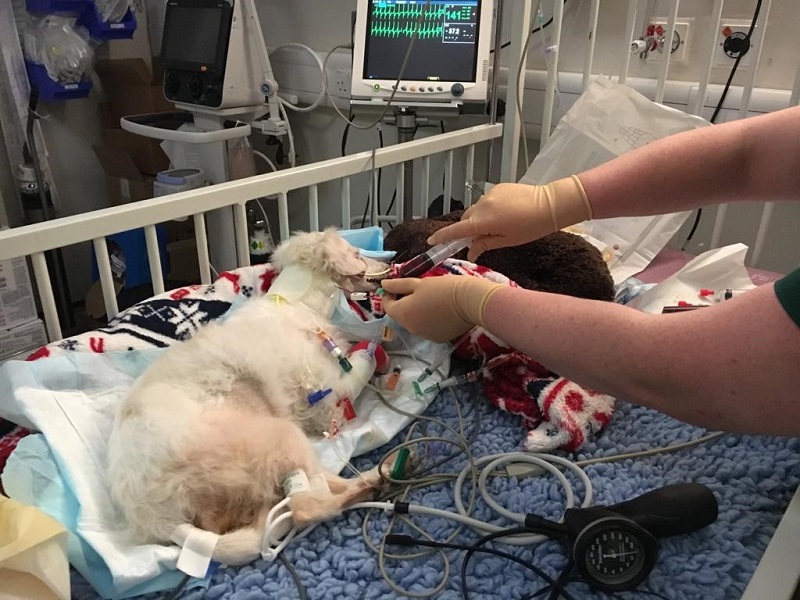Information sheet for vets: Therapeutic plasma exchange
What is therapeutic plasma exchange?
Therapeutic plasma exchange (TPE) are extracorporeal therapies which fall under the broader category of therapeutics called apheresis which means ‘to take away’. Apheresis is any process whereby blood is removed from the body, separated into its various components such that individual elements can be removed with the remaining blood then returned to the patient. Technically plasmapheresis and TPE are different. In plasmapheresis, plasma is removed but there is no replacement of the plasma component whilst in TPE, when plasma is removed, the volume is replaced by another solution such as donor plasma, crystalloid or colloids or human serum albumin. The two terms are often used interchangeably but most of the time in veterinary medicine we are performing TPE. The main goal of TPE is to remove plasma from the patient and any autoantibodies, immune complexes, toxins or inflammatory mediators that it may contain. TPE can also be used to remove certain drugs; often those which either have a higher molecular weight or that are more protein bound than drugs which can be removed by dialysis.
How do you perform TPE?
To perform TPE a large central catheter is usually placed. Depending on the methodology used, this may be a standard central catheter or a dual lumen dialysis catheter. We have two forms of TPE available at the RVC Small Animal Referrals; membrane based and centrifugal. For patients undergone membrane based TPE, the patients are connected to an extracorporeal TPE circuit which fits onto our Prismaflex machine (also used for dialysis). Blood is drawn out of the patient and passes through the specialised filter where plasma is separated using pressure across the membrane. The patient’s plasma goes into waste and we use a number of replacement fluids (typically a combination of crystalloid and donor plasma) to replace what has been removed. For smaller patients (<10-15kg) we may perform centrifugal TPE using a Cell Saver machine. Here centrifugal forces are used rather than a membrane to separate the plasma. For each treatment cycle, we usually aim to exchange between 1 to 1.4 x plasma volume of the individual patient.
What are the indications for TPE?
TPE has been used for a number of key indications in veterinary medicine. The most common reason for use is as an adjunctive therapy in dogs with immune mediated haemolytic anaemia which are responding poorly to initiating immunosuppressive therapy, where immunosuppressive therapy is contraindicated or where the rate of haemolysis and therefore subsequent requirement for transfusion is very high.
However, TPE has also been used in patients with immune mediated thrombocytopenia, lyme nephritis, systemic lupus erythematosus, pemphigus foliaceous and myasthenia gravis. Work by clinicians at the RVC has also explored the use of TPE for the management of cutaneous renal glomerular vasculopathy.
Skullberg et al (2018) 'Description of the use of plasma exchange in dogs with cutaneous and renal glomerular vasculopathy' Front. Vet. Sci https://doi.org/10.3389/fvets.2018.00161
TPE has also been used in veterinary medicine as a therapy for hyperglobulinaemia (secondary to leishmaniasis), to remove certain toxins (e.g. kernicterus) and drugs after inadvertent overdose. It is particularly useful for drugs that have high protein binding characteristics, are of medium to higher molecular weight and a low volume of distribution. Drugs which have been reported to be removed in veterinary medicine using TPE include non-steroidal anti-inflammatory drugs (e.g. ibuprofen, meloxicam, carprofen). From human medicine there is potential indication for chemotherapeutic agents (e.g. cisplatin, vincristine) and cardiac drugs (e.g. digoxin, diltiazem).
If I think that TPE could be beneficial when and how should I refer?
If you think that you have a case that would benefit from the option of TPE then please get in touch directly with the Emergency and Critical Care team. We would be pleased to either discuss suitability of TPE or to arrange referral so that we can make a full assessment of the patient.
What is known about the outcome of cases that undergo TPE?
At the moment there is relatively little information in the veterinary literature in order to drawer strong conclusions about the outcome of patients that undergo TPE. Individual case reports document the successful use of TPE. The relative advantages and disadvantage of pursuing TPE will always be discussed with clients to ensure that they are aware of the potential benefits as well as the potential complications that can be associated with this procedure.

